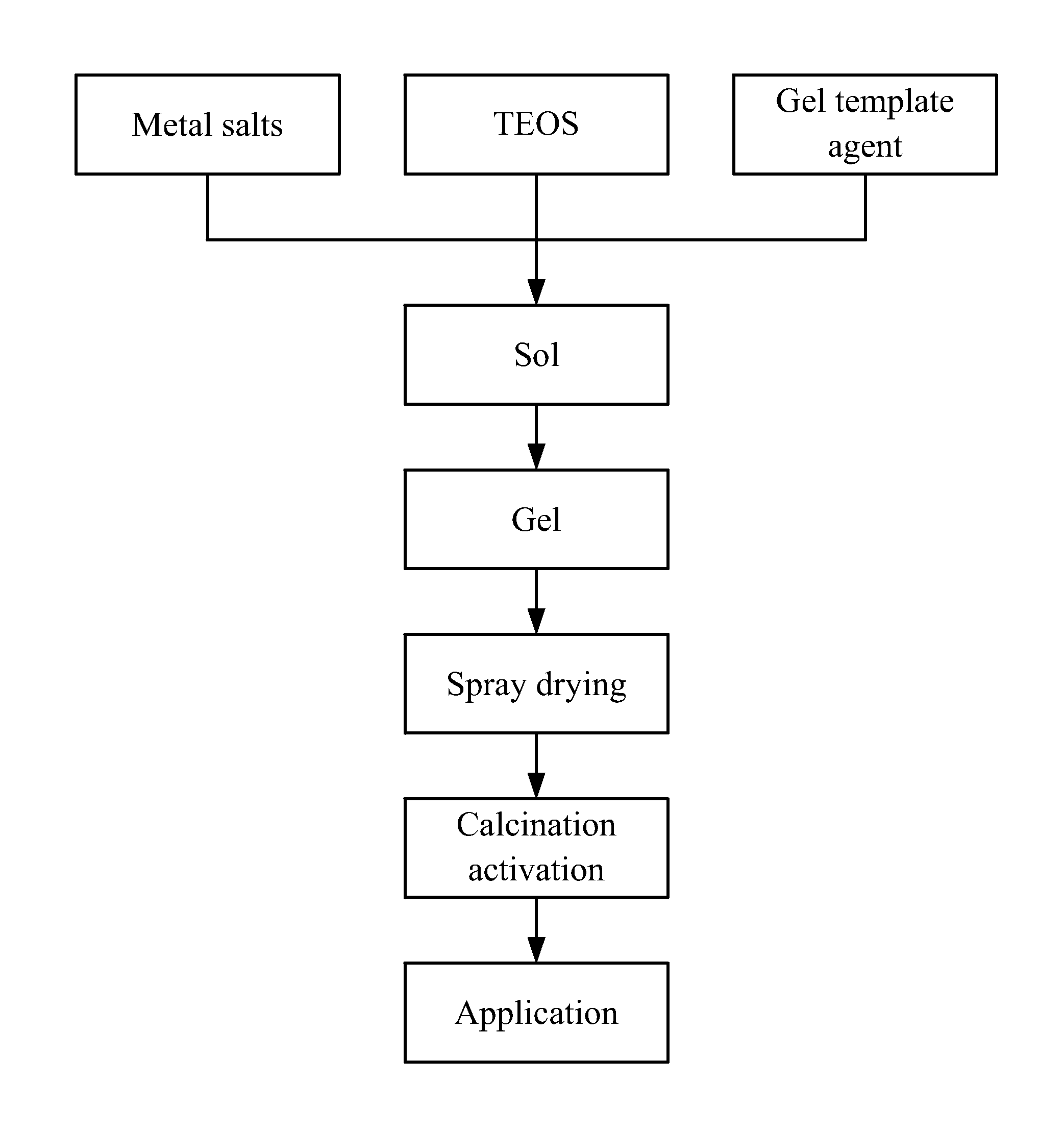Cobalt-based nano catalyst and preparation method thereof
a nano catalyst and cobalt-based technology, applied in the field of catalyst synthesis and nanomaterials, can solve the problems of low co conversion rate, complicated process, high cost of involved raw materials, etc., and achieve the effects of reducing catalyst activity, reducing catalyst activity, and reducing catalyst activity
- Summary
- Abstract
- Description
- Claims
- Application Information
AI Technical Summary
Benefits of technology
Problems solved by technology
Method used
Image
Examples
example 1
[0046]20 g of polyethyleneimine (PEI) was collected and dissolved in 100 mL of ethanol at the temperature of 80° C. to yield a solvent. Thereafter, to 100 mL of deionized water, 93.8 g of cobalt nitrate hexahydrate, 39.1 g of lanthanum nitrate hexahydrate, and 2.32 g of platinum nitrate were added and stirred for dissolving thereof to yield an aqueous solution. The aqueous solution and the solvent were then evenly mixed, added with 5 mL of ammonia, and stirred at the constant temperature for 2 hr to yield a reaction solution. TEOS of a calculated amount was added to the reaction solution and stirred at the room temperature overnight to yield a mixture. Thereafter, the mixture was spray dried to yield powder. The powder was then transferred to a muffled furnace and dried for 6 hr after the temperature slowly climbed to 400° C., whereby yielding a Fischer-Tropsch synthesis cobalt nano catalyst based on porous material confinement. Components of the nano catalyst were as follows: Co:La...
example 2
[0049]20 g of PEI was collected and dissolved in 100 mL of ethanol at the temperature of 80° C. to yield a solvent. Thereafter, to 100 mL of deionized water, 53.6 g of cobalt nitrate hexahydrate, 1.7 g of cerium nitrate hexahydrate, and 5.9 g of ruthenium nitrosyl nitrate were added and stirred for dissolving thereof to yield an aqueous solution. The aqueous solution and the solvent were then evenly mixed and stirred at the constant temperature for 2 hr to yield a reaction solution. Aluminum nitrate of a calculated amount was added to the reaction solution and stirred at the room temperature overnight to yield a mixture. Thereafter, the mixture was spray dried to yield powder. The powder was then transferred to a muffled furnace and dried for 3 hr after the temperature slowly climbed to 550° C., whereby yielding a Fischer-Tropsch synthesis cobalt nano catalyst based on porous material confinement. Components of the catalyst were as follows: Co:Ce:Ru:Al2O3=10:0.5:1.5:88.
[0050]Activat...
example 3
[0052]20 g of PEI was collected and dissolved in 100 mL of ethanol at the temperature of 80° C. to yield a solvent. Thereafter, to 100 mL of deionized water, 53.6 g of cobalt nitrate hexahydrate, 1.7 g of cerium nitrate hexahydrate, and 5.9 g of ruthenium nitrosyl nitrate were added and stirred for dissolving thereof to yield an aqueous solution. The aqueous solution and the solvent were then evenly mixed and stirred at the constant temperature for 2 hr to yield a reaction solution. TEOS of a calculated amount was added to the reaction solution and stirred at the room temperature overnight to yield a mixture. Thereafter, the mixture was spray dried to yield powder. The powder was then transferred to a muffled furnace and dried for 3 hr after the temperature slowly climbed to 450° C., whereby yielding a Fischer-Tropsch synthesis cobalt nano catalyst based on porous material confinement. Components of the catalyst were as follows: Co:Ce:Ru:SiO2=10:0.5:1.5:88.
[0053]Activation of the ca...
PUM
| Property | Measurement | Unit |
|---|---|---|
| pore size | aaaaa | aaaaa |
| pore size | aaaaa | aaaaa |
| particle size | aaaaa | aaaaa |
Abstract
Description
Claims
Application Information
 Login to View More
Login to View More - R&D
- Intellectual Property
- Life Sciences
- Materials
- Tech Scout
- Unparalleled Data Quality
- Higher Quality Content
- 60% Fewer Hallucinations
Browse by: Latest US Patents, China's latest patents, Technical Efficacy Thesaurus, Application Domain, Technology Topic, Popular Technical Reports.
© 2025 PatSnap. All rights reserved.Legal|Privacy policy|Modern Slavery Act Transparency Statement|Sitemap|About US| Contact US: help@patsnap.com


